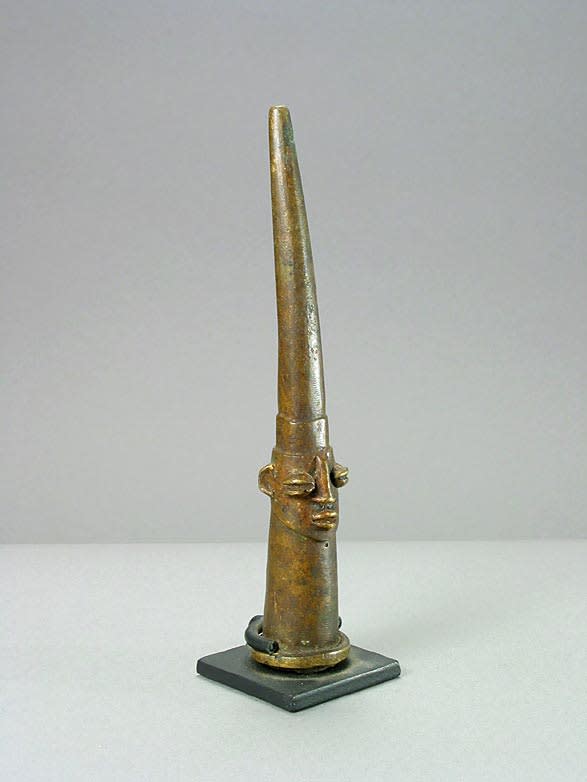Yoruba Bronze Diviners Rod, 1880 CE - 1920 CE
Bronze
PF.4968 (LSO)
Further images
This intriguing object is a diviner’s rod from the Yoruba people of Nigeria. It was originally used to tap and “draw” on a divination board known as an Ifa, in...
This intriguing object is a diviner’s rod from the Yoruba people of Nigeria. It was originally used to tap and “draw” on a divination board known as an Ifa, in order to foretell the future and guide the applicant in the manner of their life. It is an ornate example, with a pedestal base, a tapering profile and a characteristically Yoruban face mounted just below the midpoint of the piece. The eyes are coffee-bean format, with a long nose and pursed lips in the same shape as the eyes. It is exceptionally unusual in its mode of manufacture – the majority of such specimens are made of wood, or, unusually, ivory.
The Yoruba peoples of Nigeria have what is probably the longest extant artistic tradition in Africa. The nation state is comprised of numerous subsections that were joined historically by the rise and collapse of the Ife (12th to 15th centuries) and Benin (13th to 19th centuries) polities. Each of the sub-kingdoms – including Oyo, Ijebu and smaller units towards the west – had their heyday, and they are loosely united through language and culture, although they still retain a measure of independence in terms of their artistic traditions.
The Yoruba are sedentary, agriculturist and hierarchical. They are ruled by hereditary kings known as Obas, and their access to the supernatural world is supervised by a very complex arrangement of priests and spiritual channelers. Their cosmology is arranged in terms of the tangible realm of the living (aye) and the invisible realm of the spirits and the hereafter (orun). Their relationship is sometimes described as being that of a gourd with tightly-interlocking upper and lower halves, or as a divination board with a raised rim and a depressed centre. Ase – life force – is controlled by the creator god (Olodumare), and it is to him that most appeals are sent through human intermediaries such as the babalawo (diviner).
As mentioned above, the divination board – or Ifa – is symbolic of the Yoruba cosmos. The duality of the visible and spiritual worlds is represented by the board’s plain centre and decorated rim, which displays mythologically and historically-significant symbols as well as everyday concerns that might be broached during a consultation. The board is usually covered with a thin layer of sawdust. The diviner will use a “tapper” such as this to draw lines separating out the three paths of life, in order to open the channels of spiritual communication. A set of sixteen palm-nuts (Ikin) or a chain (Opele)is then thrown onto the board; the manner in which they land enables the babalawo to inform the client as to the spiritual forces at work in his or her life, the means by which to avoid ill-fortune (sacrifice, usually) and how to stabilise their spiritual harmonies. This tradition has been prevalent in West Africa for at least 500 years if not considerably longer, and it is a fundamental part of Yoruban life.
This is an attractive and significant piece of African art.
The Yoruba peoples of Nigeria have what is probably the longest extant artistic tradition in Africa. The nation state is comprised of numerous subsections that were joined historically by the rise and collapse of the Ife (12th to 15th centuries) and Benin (13th to 19th centuries) polities. Each of the sub-kingdoms – including Oyo, Ijebu and smaller units towards the west – had their heyday, and they are loosely united through language and culture, although they still retain a measure of independence in terms of their artistic traditions.
The Yoruba are sedentary, agriculturist and hierarchical. They are ruled by hereditary kings known as Obas, and their access to the supernatural world is supervised by a very complex arrangement of priests and spiritual channelers. Their cosmology is arranged in terms of the tangible realm of the living (aye) and the invisible realm of the spirits and the hereafter (orun). Their relationship is sometimes described as being that of a gourd with tightly-interlocking upper and lower halves, or as a divination board with a raised rim and a depressed centre. Ase – life force – is controlled by the creator god (Olodumare), and it is to him that most appeals are sent through human intermediaries such as the babalawo (diviner).
As mentioned above, the divination board – or Ifa – is symbolic of the Yoruba cosmos. The duality of the visible and spiritual worlds is represented by the board’s plain centre and decorated rim, which displays mythologically and historically-significant symbols as well as everyday concerns that might be broached during a consultation. The board is usually covered with a thin layer of sawdust. The diviner will use a “tapper” such as this to draw lines separating out the three paths of life, in order to open the channels of spiritual communication. A set of sixteen palm-nuts (Ikin) or a chain (Opele)is then thrown onto the board; the manner in which they land enables the babalawo to inform the client as to the spiritual forces at work in his or her life, the means by which to avoid ill-fortune (sacrifice, usually) and how to stabilise their spiritual harmonies. This tradition has been prevalent in West Africa for at least 500 years if not considerably longer, and it is a fundamental part of Yoruban life.
This is an attractive and significant piece of African art.







